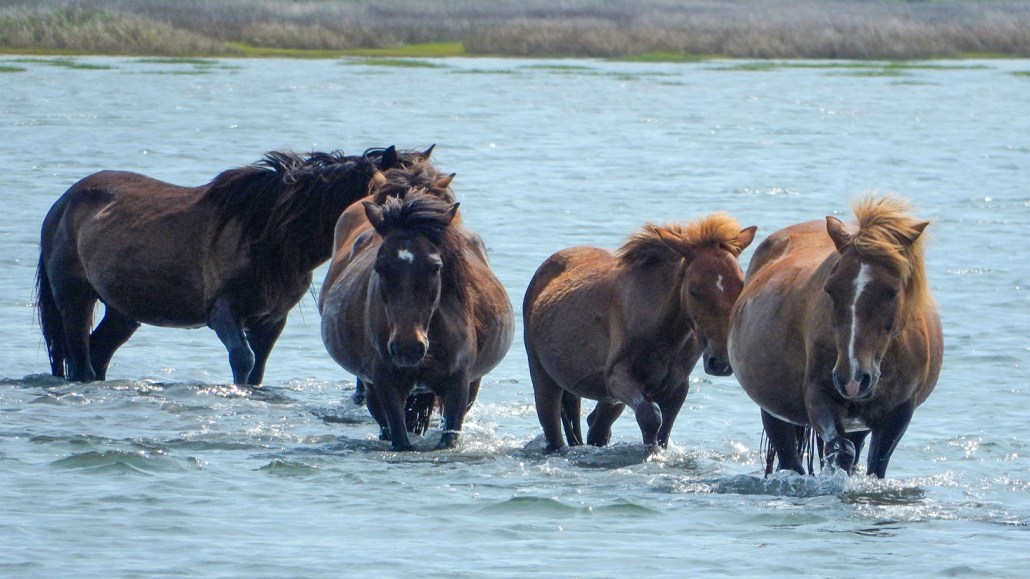Among mammals, males aren’t usually bigger than females
Biologists long assumed females were typically smaller. That’s not true, new data suggest

In many mammals, such as these feral horses in Shackleford Banks Island, N.C., males and females are roughly the same size.
Daniel Rubenstein
Share this:
- Share via email (Opens in new window) Email
- Click to share on Facebook (Opens in new window) Facebook
- Click to share on X (Opens in new window) X
- Click to share on Pinterest (Opens in new window) Pinterest
- Click to share on Reddit (Opens in new window) Reddit
- Share to Google Classroom (Opens in new window) Google Classroom
- Click to print (Opens in new window) Print
Scientists have long thought that when it comes to mammals, males tend to be larger than females. That may not be true after all, it now appears.
A new study looked at hundreds of mammal species. In just over half, females are as big as or bigger than males.
Researchers shared their new findings March 12 in Nature Communications.
The idea that male mammals are bigger than females has “just been this assumption,” says Kaia Tombak. Most people just went along with it, “without good evidence,” she says. An evolutionary biologist, Tombak works at Purdue University. That’s in West Lafayette, Ind.
It’s well-known that males and females of the same species can differ in size. This is known as sexual size dimorphism (Dy-MORF-izm). To understand why these differences arise, biologists have often looked at big, flashy mammals. Think lions or gorillas. These species often do have larger males. But focusing on them ignores lots of other species.
What’s more, some past studies didn’t report how animal size can vary within a species, Tombak notes. That makes it hard to tell for sure whether the males of a species really are, on average, bigger than the females.
“We tried to get at this question by being a bit more rigorous,” she says.
Tombak was part of a team that looked at data on the weights of males and females in 429 mammal species. In 45 percent of them, males tended to be heavier than females. In 16 percent of species, females were heavier. In 39 percent, males and females were about the same size.
The team found similar trends when they looked at data on how long animals were.
Well-studied groups — think carnivores, primates and hoofed animals — tended to have heavier males. But nearly half of bats had heavier females. And in about half of rodents, males and females weighed about the same.
One limit of this study: It looked at only about 5 percent of all mammal species. But these did come from across the mammal family tree, Tombak says. So she’s confident the team got the overall picture of differences in mammal size right.
@sciencenewsofficial Think male mammals are usually bigger than females? Think again. #mammals #animals #evolution #science
♬ original sound – sciencenewsofficial
Past studies have shown that larger female animals are quite common. But “the research has been male-centered,” says Malin Ah-King. She’s an evolutionary biologist at Stockholm University in Sweden. She did not take part in the new work.
The evolution of females often has been overlooked, Ah-King says. As a result, the notion that male mammals tend to be bigger has just become accepted.
That supposed size difference has shaped scientists’ ideas about how mammals mate. Often, the story goes, bigger bodies give the males an edge in battle. And that helps them get the attention of smaller female mates. The new finding that many species do not actually have larger males complicates that story.
“The real power of this study … is that they were very careful and methodical,” says Catherine Sheard. She’s an evolutionary biologist at the University of Aberdeen in Scotland. The results show that “there are things that people just blithely assume because they haven’t thought about it” that deeply, she says.
Ditching those assumptions can free biologists to ask new questions, Sheard says. For instance, why are females bigger in some species? Or, what forces keep males and females in other species the same size?
The new study, Sheard says, “has opened up a clearer understanding of what’s going on in the natural world.”







